Financial Report Analysis: Wesfarmers Accounting Policies and Strategy
VerifiedAdded on 2020/04/07
|21
|4102
|97
Report
AI Summary
This report provides a comprehensive analysis of Wesfarmers Limited's accounting policies and financial reporting practices. It begins by identifying key accounting policies and assessing the flexibility management has in implementing them. The report then evaluates Wesfarmers' accounting strategy, comparing it to that of its competitor, Woolworths Limited, and analyzing the company's approach to risk management and incentive schemes. A detailed examination of the disclosures made in Wesfarmers' financial statements follows, with an assessment of their reliability, relevance, comparability, and understandability. The report also highlights potential red flags in the annual report, such as the absence of footnotes, and concludes with an evaluation of the company's compliance with the Conceptual Framework. The report underscores the importance of transparency and sound accounting practices for business corporations.
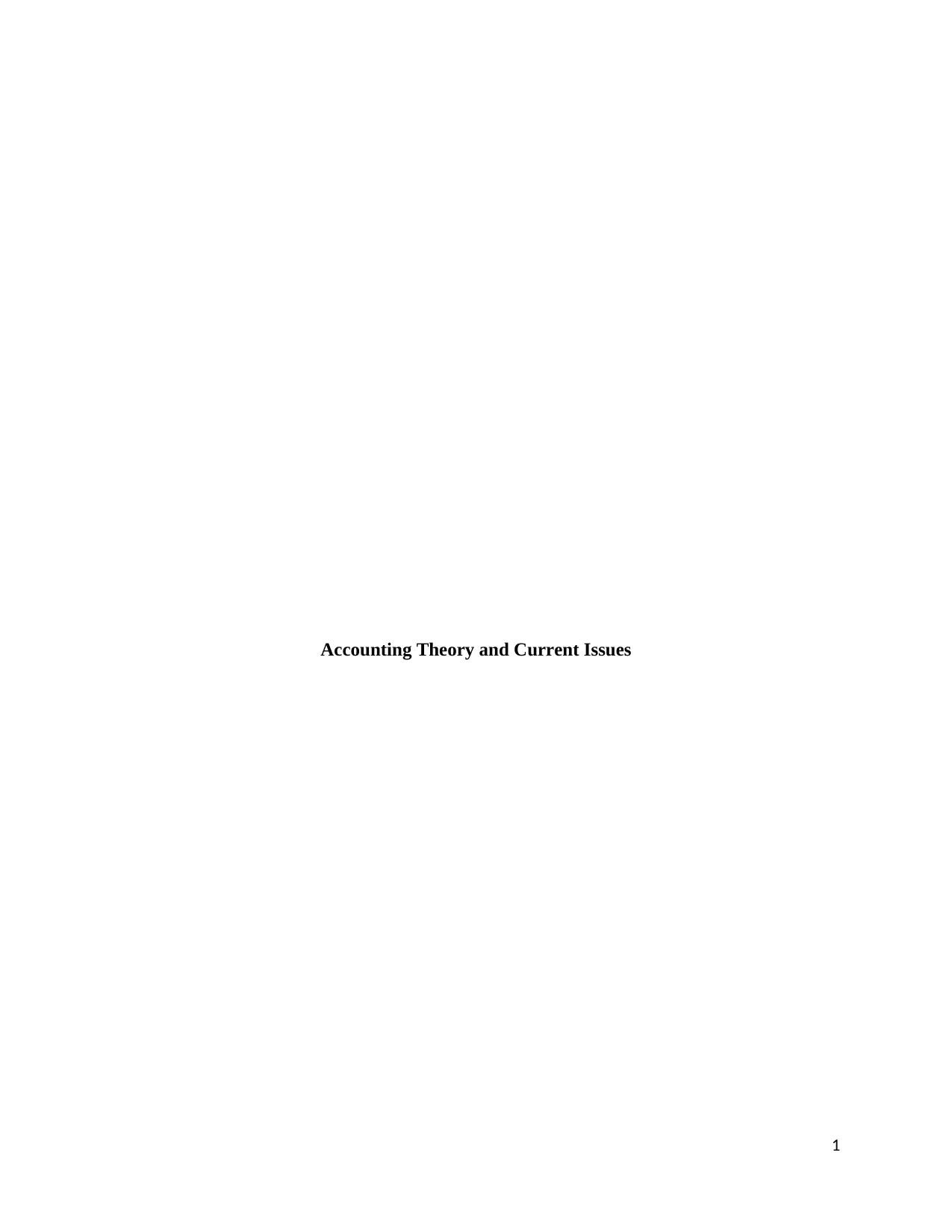
Accounting Theory and Current Issues
1
1
Paraphrase This Document
Need a fresh take? Get an instant paraphrase of this document with our AI Paraphraser
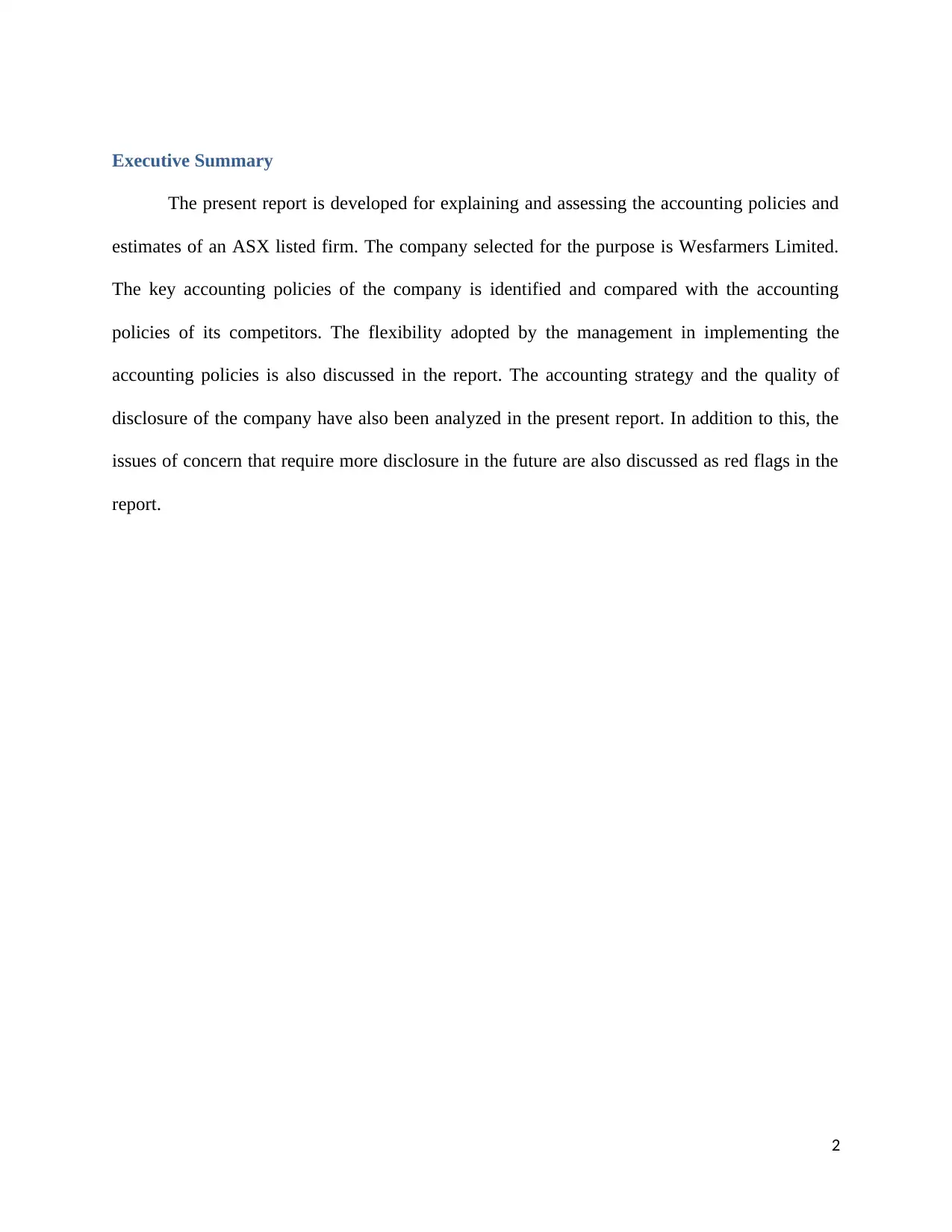
Executive Summary
The present report is developed for explaining and assessing the accounting policies and
estimates of an ASX listed firm. The company selected for the purpose is Wesfarmers Limited.
The key accounting policies of the company is identified and compared with the accounting
policies of its competitors. The flexibility adopted by the management in implementing the
accounting policies is also discussed in the report. The accounting strategy and the quality of
disclosure of the company have also been analyzed in the present report. In addition to this, the
issues of concern that require more disclosure in the future are also discussed as red flags in the
report.
2
The present report is developed for explaining and assessing the accounting policies and
estimates of an ASX listed firm. The company selected for the purpose is Wesfarmers Limited.
The key accounting policies of the company is identified and compared with the accounting
policies of its competitors. The flexibility adopted by the management in implementing the
accounting policies is also discussed in the report. The accounting strategy and the quality of
disclosure of the company have also been analyzed in the present report. In addition to this, the
issues of concern that require more disclosure in the future are also discussed as red flags in the
report.
2
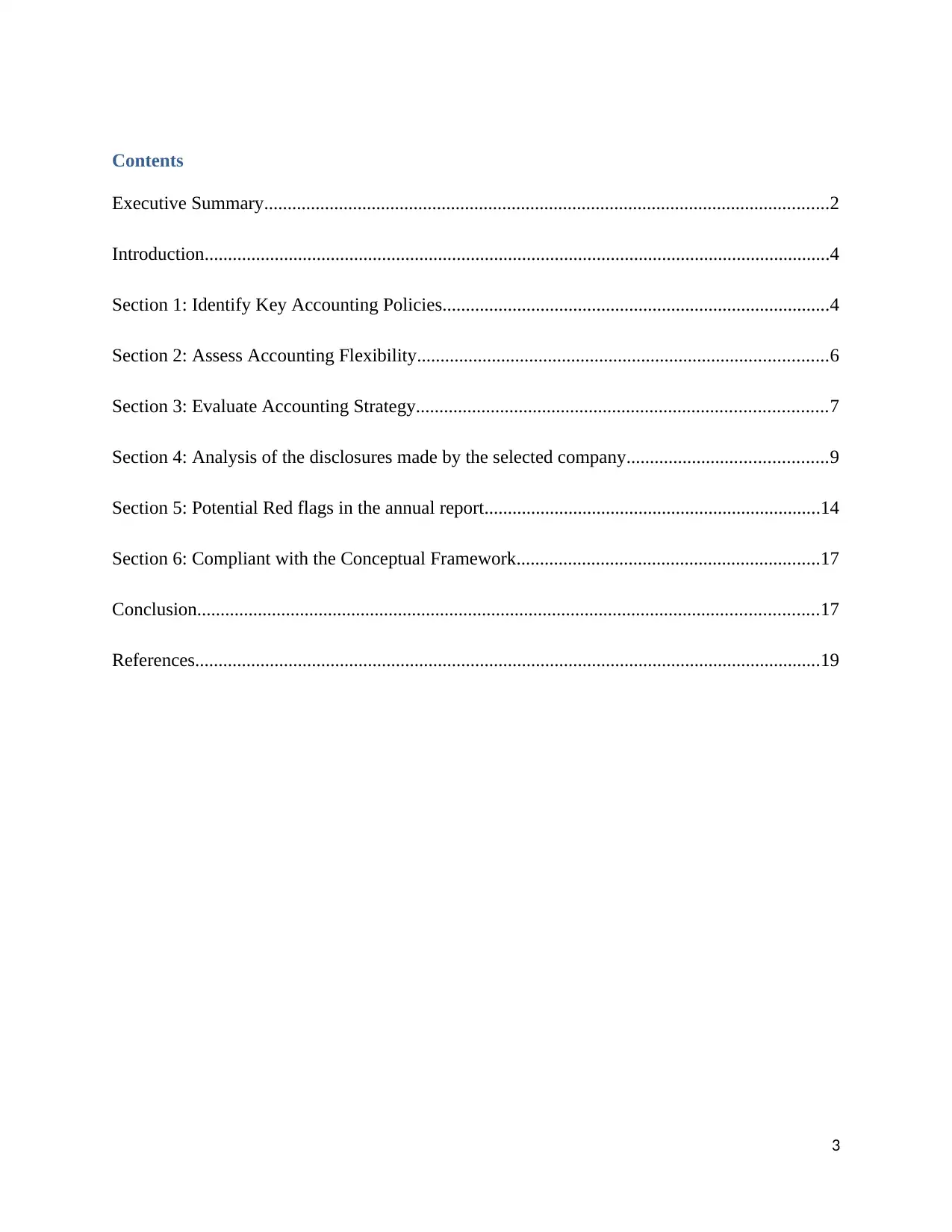
Contents
Executive Summary.........................................................................................................................2
Introduction......................................................................................................................................4
Section 1: Identify Key Accounting Policies...................................................................................4
Section 2: Assess Accounting Flexibility........................................................................................6
Section 3: Evaluate Accounting Strategy........................................................................................7
Section 4: Analysis of the disclosures made by the selected company...........................................9
Section 5: Potential Red flags in the annual report........................................................................14
Section 6: Compliant with the Conceptual Framework.................................................................17
Conclusion.....................................................................................................................................17
References......................................................................................................................................19
3
Executive Summary.........................................................................................................................2
Introduction......................................................................................................................................4
Section 1: Identify Key Accounting Policies...................................................................................4
Section 2: Assess Accounting Flexibility........................................................................................6
Section 3: Evaluate Accounting Strategy........................................................................................7
Section 4: Analysis of the disclosures made by the selected company...........................................9
Section 5: Potential Red flags in the annual report........................................................................14
Section 6: Compliant with the Conceptual Framework.................................................................17
Conclusion.....................................................................................................................................17
References......................................................................................................................................19
3
⊘ This is a preview!⊘
Do you want full access?
Subscribe today to unlock all pages.

Trusted by 1+ million students worldwide
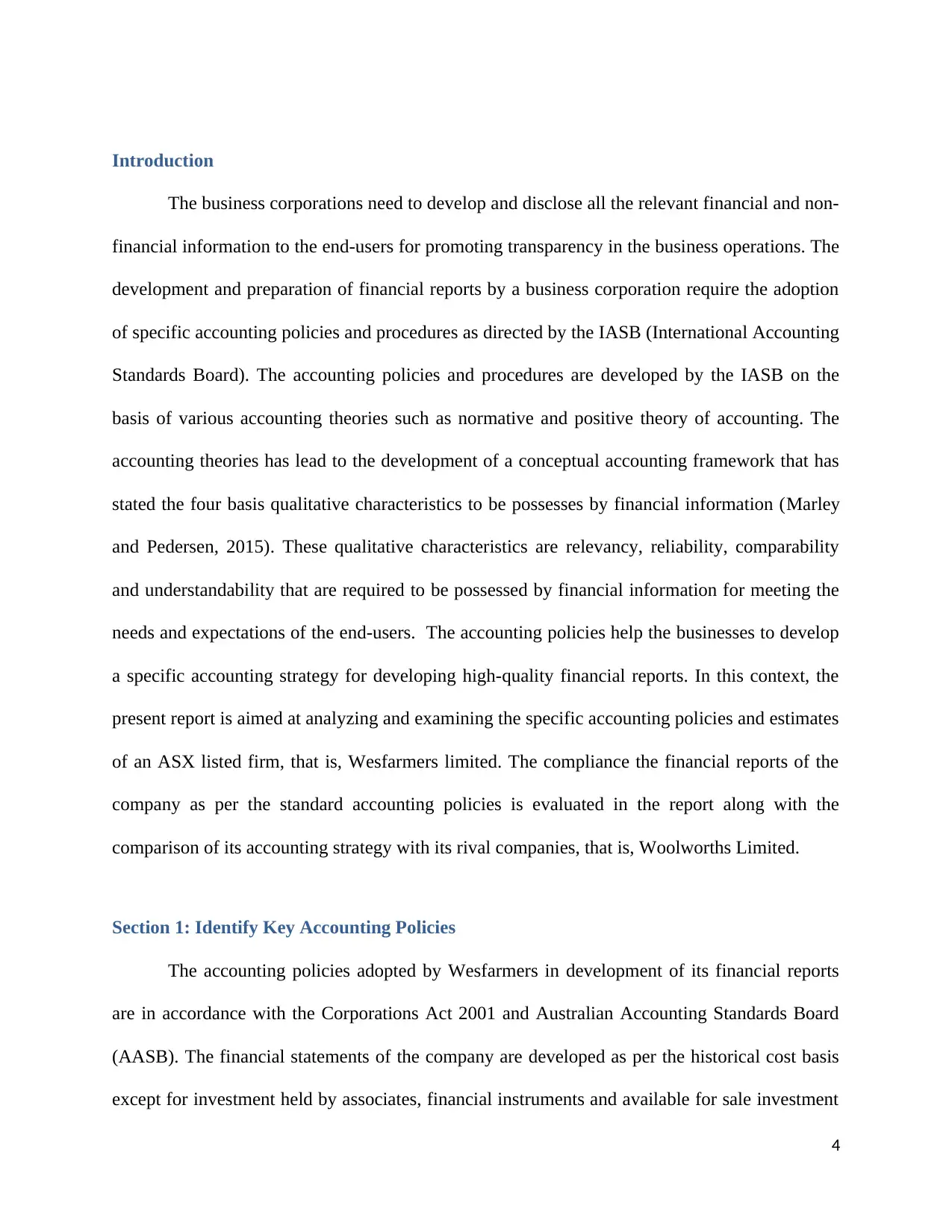
Introduction
The business corporations need to develop and disclose all the relevant financial and non-
financial information to the end-users for promoting transparency in the business operations. The
development and preparation of financial reports by a business corporation require the adoption
of specific accounting policies and procedures as directed by the IASB (International Accounting
Standards Board). The accounting policies and procedures are developed by the IASB on the
basis of various accounting theories such as normative and positive theory of accounting. The
accounting theories has lead to the development of a conceptual accounting framework that has
stated the four basis qualitative characteristics to be possesses by financial information (Marley
and Pedersen, 2015). These qualitative characteristics are relevancy, reliability, comparability
and understandability that are required to be possessed by financial information for meeting the
needs and expectations of the end-users. The accounting policies help the businesses to develop
a specific accounting strategy for developing high-quality financial reports. In this context, the
present report is aimed at analyzing and examining the specific accounting policies and estimates
of an ASX listed firm, that is, Wesfarmers limited. The compliance the financial reports of the
company as per the standard accounting policies is evaluated in the report along with the
comparison of its accounting strategy with its rival companies, that is, Woolworths Limited.
Section 1: Identify Key Accounting Policies
The accounting policies adopted by Wesfarmers in development of its financial reports
are in accordance with the Corporations Act 2001 and Australian Accounting Standards Board
(AASB). The financial statements of the company are developed as per the historical cost basis
except for investment held by associates, financial instruments and available for sale investment
4
The business corporations need to develop and disclose all the relevant financial and non-
financial information to the end-users for promoting transparency in the business operations. The
development and preparation of financial reports by a business corporation require the adoption
of specific accounting policies and procedures as directed by the IASB (International Accounting
Standards Board). The accounting policies and procedures are developed by the IASB on the
basis of various accounting theories such as normative and positive theory of accounting. The
accounting theories has lead to the development of a conceptual accounting framework that has
stated the four basis qualitative characteristics to be possesses by financial information (Marley
and Pedersen, 2015). These qualitative characteristics are relevancy, reliability, comparability
and understandability that are required to be possessed by financial information for meeting the
needs and expectations of the end-users. The accounting policies help the businesses to develop
a specific accounting strategy for developing high-quality financial reports. In this context, the
present report is aimed at analyzing and examining the specific accounting policies and estimates
of an ASX listed firm, that is, Wesfarmers limited. The compliance the financial reports of the
company as per the standard accounting policies is evaluated in the report along with the
comparison of its accounting strategy with its rival companies, that is, Woolworths Limited.
Section 1: Identify Key Accounting Policies
The accounting policies adopted by Wesfarmers in development of its financial reports
are in accordance with the Corporations Act 2001 and Australian Accounting Standards Board
(AASB). The financial statements of the company are developed as per the historical cost basis
except for investment held by associates, financial instruments and available for sale investment
4
Paraphrase This Document
Need a fresh take? Get an instant paraphrase of this document with our AI Paraphraser
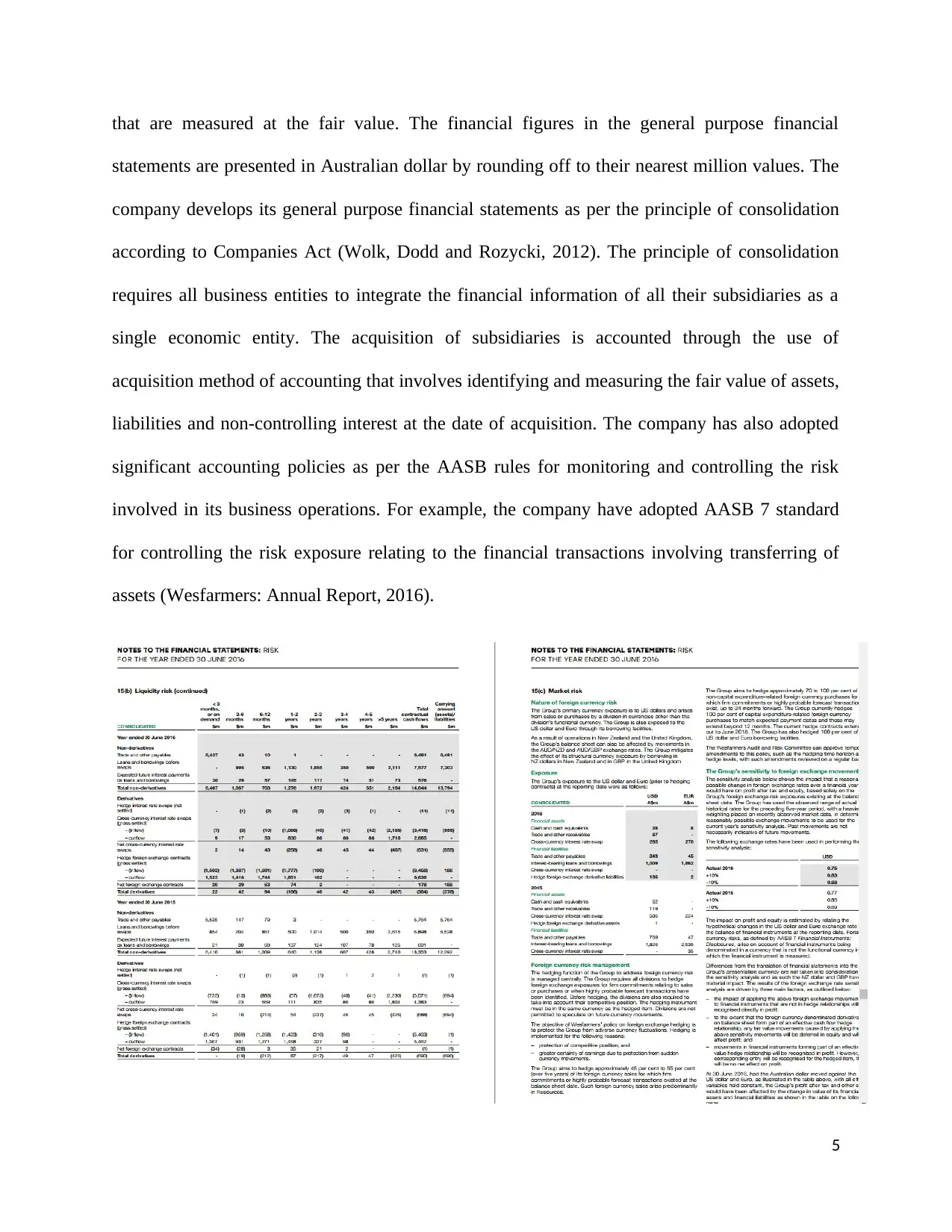
that are measured at the fair value. The financial figures in the general purpose financial
statements are presented in Australian dollar by rounding off to their nearest million values. The
company develops its general purpose financial statements as per the principle of consolidation
according to Companies Act (Wolk, Dodd and Rozycki, 2012). The principle of consolidation
requires all business entities to integrate the financial information of all their subsidiaries as a
single economic entity. The acquisition of subsidiaries is accounted through the use of
acquisition method of accounting that involves identifying and measuring the fair value of assets,
liabilities and non-controlling interest at the date of acquisition. The company has also adopted
significant accounting policies as per the AASB rules for monitoring and controlling the risk
involved in its business operations. For example, the company have adopted AASB 7 standard
for controlling the risk exposure relating to the financial transactions involving transferring of
assets (Wesfarmers: Annual Report, 2016).
5
statements are presented in Australian dollar by rounding off to their nearest million values. The
company develops its general purpose financial statements as per the principle of consolidation
according to Companies Act (Wolk, Dodd and Rozycki, 2012). The principle of consolidation
requires all business entities to integrate the financial information of all their subsidiaries as a
single economic entity. The acquisition of subsidiaries is accounted through the use of
acquisition method of accounting that involves identifying and measuring the fair value of assets,
liabilities and non-controlling interest at the date of acquisition. The company has also adopted
significant accounting policies as per the AASB rules for monitoring and controlling the risk
involved in its business operations. For example, the company have adopted AASB 7 standard
for controlling the risk exposure relating to the financial transactions involving transferring of
assets (Wesfarmers: Annual Report, 2016).
5
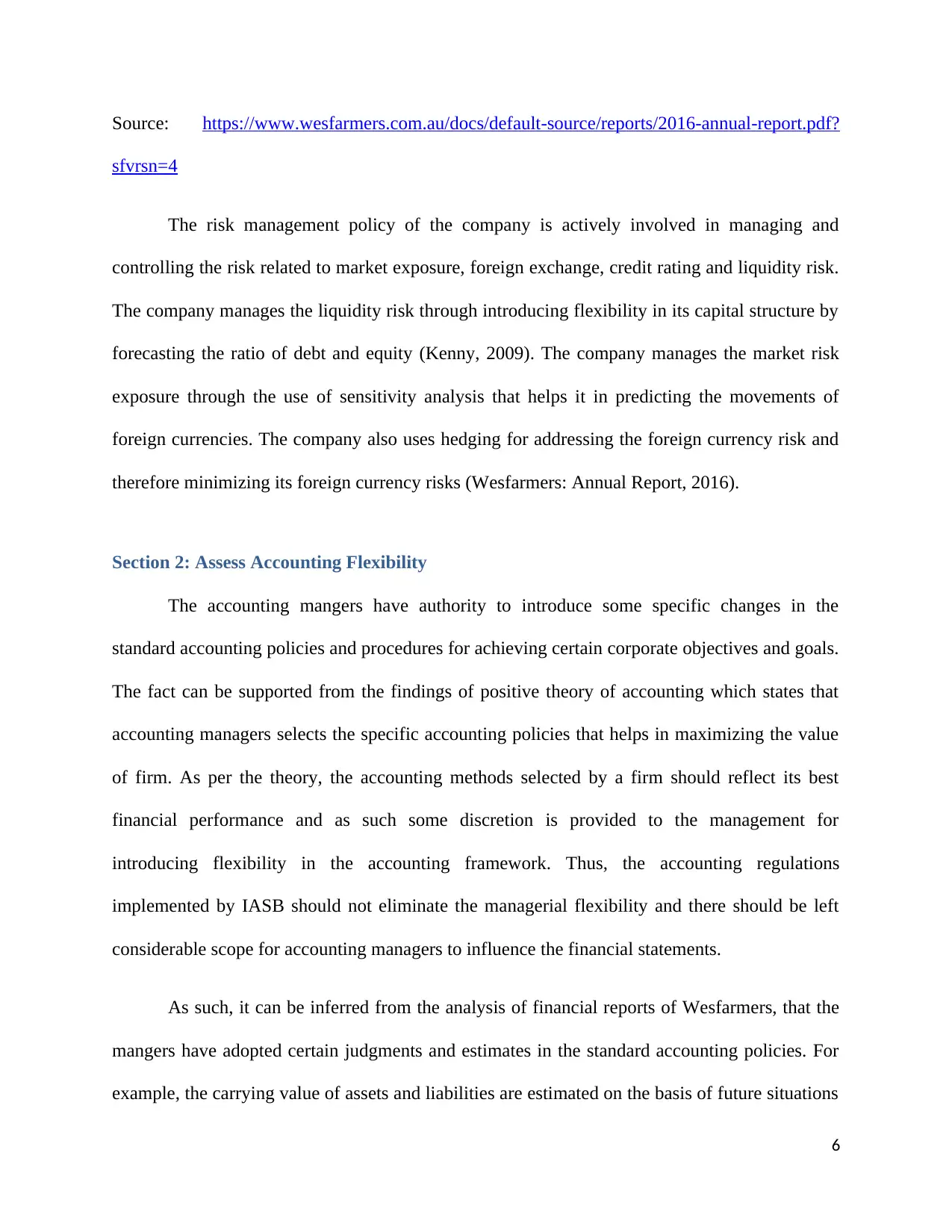
Source: https://www.wesfarmers.com.au/docs/default-source/reports/2016-annual-report.pdf?
sfvrsn=4
The risk management policy of the company is actively involved in managing and
controlling the risk related to market exposure, foreign exchange, credit rating and liquidity risk.
The company manages the liquidity risk through introducing flexibility in its capital structure by
forecasting the ratio of debt and equity (Kenny, 2009). The company manages the market risk
exposure through the use of sensitivity analysis that helps it in predicting the movements of
foreign currencies. The company also uses hedging for addressing the foreign currency risk and
therefore minimizing its foreign currency risks (Wesfarmers: Annual Report, 2016).
Section 2: Assess Accounting Flexibility
The accounting mangers have authority to introduce some specific changes in the
standard accounting policies and procedures for achieving certain corporate objectives and goals.
The fact can be supported from the findings of positive theory of accounting which states that
accounting managers selects the specific accounting policies that helps in maximizing the value
of firm. As per the theory, the accounting methods selected by a firm should reflect its best
financial performance and as such some discretion is provided to the management for
introducing flexibility in the accounting framework. Thus, the accounting regulations
implemented by IASB should not eliminate the managerial flexibility and there should be left
considerable scope for accounting managers to influence the financial statements.
As such, it can be inferred from the analysis of financial reports of Wesfarmers, that the
mangers have adopted certain judgments and estimates in the standard accounting policies. For
example, the carrying value of assets and liabilities are estimated on the basis of future situations
6
sfvrsn=4
The risk management policy of the company is actively involved in managing and
controlling the risk related to market exposure, foreign exchange, credit rating and liquidity risk.
The company manages the liquidity risk through introducing flexibility in its capital structure by
forecasting the ratio of debt and equity (Kenny, 2009). The company manages the market risk
exposure through the use of sensitivity analysis that helps it in predicting the movements of
foreign currencies. The company also uses hedging for addressing the foreign currency risk and
therefore minimizing its foreign currency risks (Wesfarmers: Annual Report, 2016).
Section 2: Assess Accounting Flexibility
The accounting mangers have authority to introduce some specific changes in the
standard accounting policies and procedures for achieving certain corporate objectives and goals.
The fact can be supported from the findings of positive theory of accounting which states that
accounting managers selects the specific accounting policies that helps in maximizing the value
of firm. As per the theory, the accounting methods selected by a firm should reflect its best
financial performance and as such some discretion is provided to the management for
introducing flexibility in the accounting framework. Thus, the accounting regulations
implemented by IASB should not eliminate the managerial flexibility and there should be left
considerable scope for accounting managers to influence the financial statements.
As such, it can be inferred from the analysis of financial reports of Wesfarmers, that the
mangers have adopted certain judgments and estimates in the standard accounting policies. For
example, the carrying value of assets and liabilities are estimated on the basis of future situations
6
⊘ This is a preview!⊘
Do you want full access?
Subscribe today to unlock all pages.

Trusted by 1+ million students worldwide
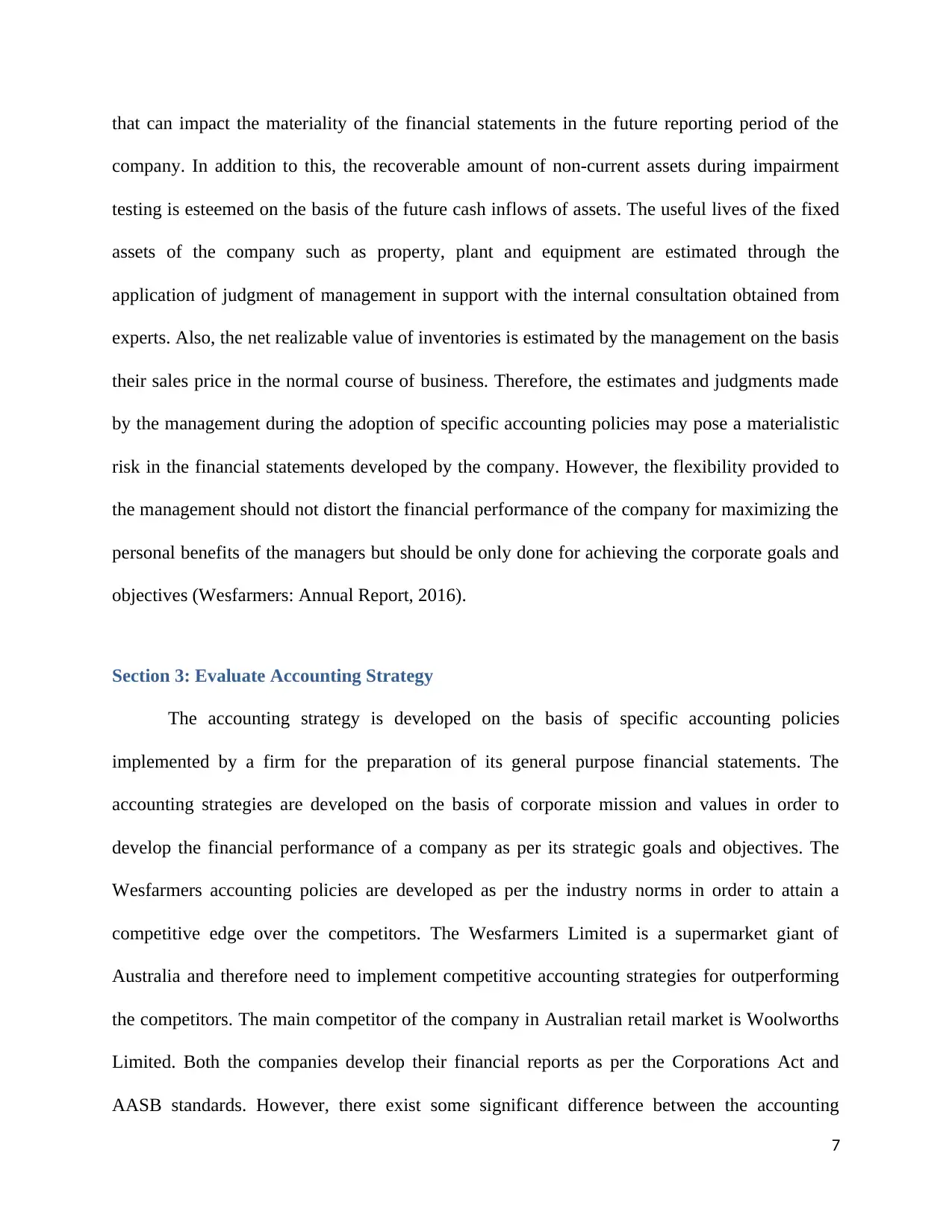
that can impact the materiality of the financial statements in the future reporting period of the
company. In addition to this, the recoverable amount of non-current assets during impairment
testing is esteemed on the basis of the future cash inflows of assets. The useful lives of the fixed
assets of the company such as property, plant and equipment are estimated through the
application of judgment of management in support with the internal consultation obtained from
experts. Also, the net realizable value of inventories is estimated by the management on the basis
their sales price in the normal course of business. Therefore, the estimates and judgments made
by the management during the adoption of specific accounting policies may pose a materialistic
risk in the financial statements developed by the company. However, the flexibility provided to
the management should not distort the financial performance of the company for maximizing the
personal benefits of the managers but should be only done for achieving the corporate goals and
objectives (Wesfarmers: Annual Report, 2016).
Section 3: Evaluate Accounting Strategy
The accounting strategy is developed on the basis of specific accounting policies
implemented by a firm for the preparation of its general purpose financial statements. The
accounting strategies are developed on the basis of corporate mission and values in order to
develop the financial performance of a company as per its strategic goals and objectives. The
Wesfarmers accounting policies are developed as per the industry norms in order to attain a
competitive edge over the competitors. The Wesfarmers Limited is a supermarket giant of
Australia and therefore need to implement competitive accounting strategies for outperforming
the competitors. The main competitor of the company in Australian retail market is Woolworths
Limited. Both the companies develop their financial reports as per the Corporations Act and
AASB standards. However, there exist some significant difference between the accounting
7
company. In addition to this, the recoverable amount of non-current assets during impairment
testing is esteemed on the basis of the future cash inflows of assets. The useful lives of the fixed
assets of the company such as property, plant and equipment are estimated through the
application of judgment of management in support with the internal consultation obtained from
experts. Also, the net realizable value of inventories is estimated by the management on the basis
their sales price in the normal course of business. Therefore, the estimates and judgments made
by the management during the adoption of specific accounting policies may pose a materialistic
risk in the financial statements developed by the company. However, the flexibility provided to
the management should not distort the financial performance of the company for maximizing the
personal benefits of the managers but should be only done for achieving the corporate goals and
objectives (Wesfarmers: Annual Report, 2016).
Section 3: Evaluate Accounting Strategy
The accounting strategy is developed on the basis of specific accounting policies
implemented by a firm for the preparation of its general purpose financial statements. The
accounting strategies are developed on the basis of corporate mission and values in order to
develop the financial performance of a company as per its strategic goals and objectives. The
Wesfarmers accounting policies are developed as per the industry norms in order to attain a
competitive edge over the competitors. The Wesfarmers Limited is a supermarket giant of
Australia and therefore need to implement competitive accounting strategies for outperforming
the competitors. The main competitor of the company in Australian retail market is Woolworths
Limited. Both the companies develop their financial reports as per the Corporations Act and
AASB standards. However, there exist some significant difference between the accounting
7
Paraphrase This Document
Need a fresh take? Get an instant paraphrase of this document with our AI Paraphraser
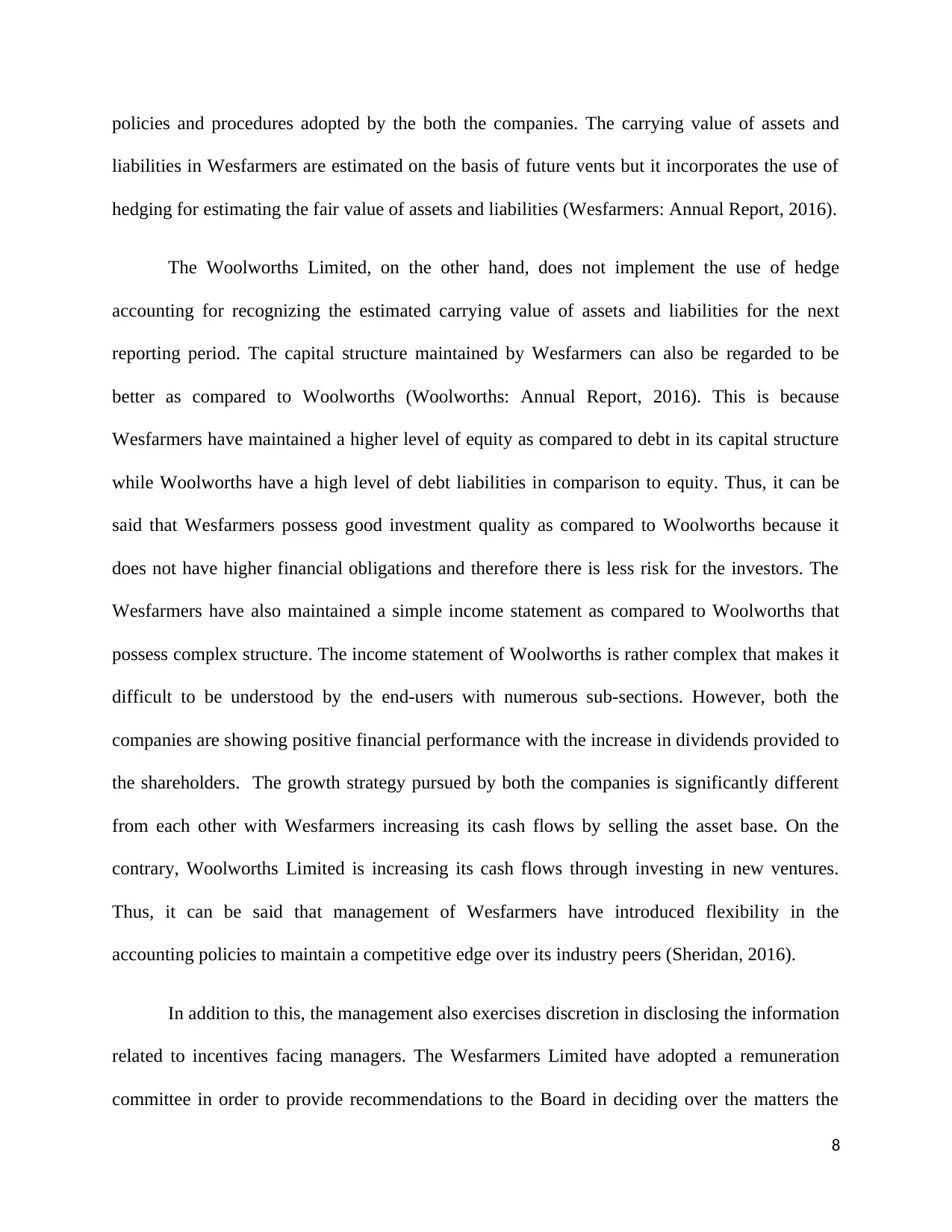
policies and procedures adopted by the both the companies. The carrying value of assets and
liabilities in Wesfarmers are estimated on the basis of future vents but it incorporates the use of
hedging for estimating the fair value of assets and liabilities (Wesfarmers: Annual Report, 2016).
The Woolworths Limited, on the other hand, does not implement the use of hedge
accounting for recognizing the estimated carrying value of assets and liabilities for the next
reporting period. The capital structure maintained by Wesfarmers can also be regarded to be
better as compared to Woolworths (Woolworths: Annual Report, 2016). This is because
Wesfarmers have maintained a higher level of equity as compared to debt in its capital structure
while Woolworths have a high level of debt liabilities in comparison to equity. Thus, it can be
said that Wesfarmers possess good investment quality as compared to Woolworths because it
does not have higher financial obligations and therefore there is less risk for the investors. The
Wesfarmers have also maintained a simple income statement as compared to Woolworths that
possess complex structure. The income statement of Woolworths is rather complex that makes it
difficult to be understood by the end-users with numerous sub-sections. However, both the
companies are showing positive financial performance with the increase in dividends provided to
the shareholders. The growth strategy pursued by both the companies is significantly different
from each other with Wesfarmers increasing its cash flows by selling the asset base. On the
contrary, Woolworths Limited is increasing its cash flows through investing in new ventures.
Thus, it can be said that management of Wesfarmers have introduced flexibility in the
accounting policies to maintain a competitive edge over its industry peers (Sheridan, 2016).
In addition to this, the management also exercises discretion in disclosing the information
related to incentives facing managers. The Wesfarmers Limited have adopted a remuneration
committee in order to provide recommendations to the Board in deciding over the matters the
8
liabilities in Wesfarmers are estimated on the basis of future vents but it incorporates the use of
hedging for estimating the fair value of assets and liabilities (Wesfarmers: Annual Report, 2016).
The Woolworths Limited, on the other hand, does not implement the use of hedge
accounting for recognizing the estimated carrying value of assets and liabilities for the next
reporting period. The capital structure maintained by Wesfarmers can also be regarded to be
better as compared to Woolworths (Woolworths: Annual Report, 2016). This is because
Wesfarmers have maintained a higher level of equity as compared to debt in its capital structure
while Woolworths have a high level of debt liabilities in comparison to equity. Thus, it can be
said that Wesfarmers possess good investment quality as compared to Woolworths because it
does not have higher financial obligations and therefore there is less risk for the investors. The
Wesfarmers have also maintained a simple income statement as compared to Woolworths that
possess complex structure. The income statement of Woolworths is rather complex that makes it
difficult to be understood by the end-users with numerous sub-sections. However, both the
companies are showing positive financial performance with the increase in dividends provided to
the shareholders. The growth strategy pursued by both the companies is significantly different
from each other with Wesfarmers increasing its cash flows by selling the asset base. On the
contrary, Woolworths Limited is increasing its cash flows through investing in new ventures.
Thus, it can be said that management of Wesfarmers have introduced flexibility in the
accounting policies to maintain a competitive edge over its industry peers (Sheridan, 2016).
In addition to this, the management also exercises discretion in disclosing the information
related to incentives facing managers. The Wesfarmers Limited have adopted a remuneration
committee in order to provide recommendations to the Board in deciding over the matters the
8
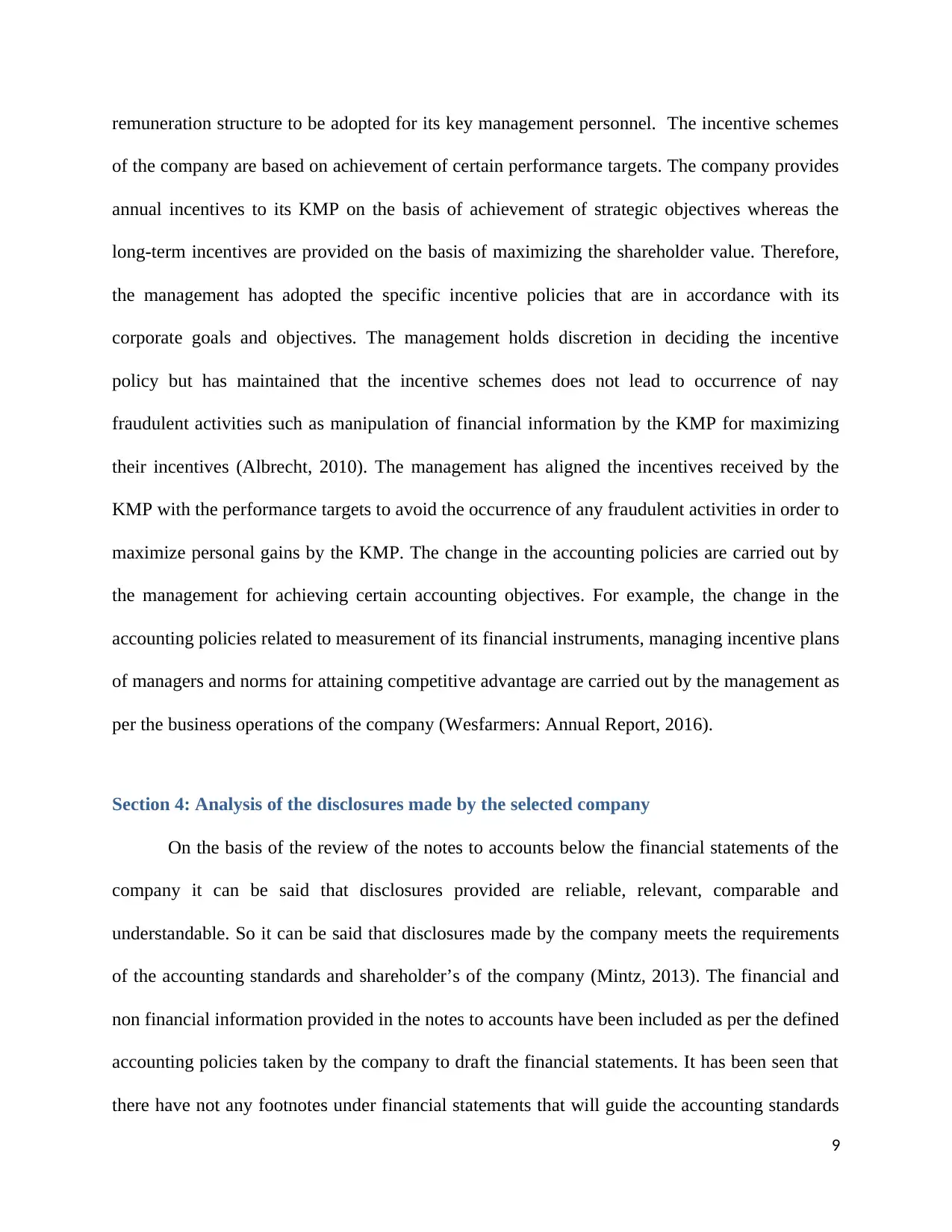
remuneration structure to be adopted for its key management personnel. The incentive schemes
of the company are based on achievement of certain performance targets. The company provides
annual incentives to its KMP on the basis of achievement of strategic objectives whereas the
long-term incentives are provided on the basis of maximizing the shareholder value. Therefore,
the management has adopted the specific incentive policies that are in accordance with its
corporate goals and objectives. The management holds discretion in deciding the incentive
policy but has maintained that the incentive schemes does not lead to occurrence of nay
fraudulent activities such as manipulation of financial information by the KMP for maximizing
their incentives (Albrecht, 2010). The management has aligned the incentives received by the
KMP with the performance targets to avoid the occurrence of any fraudulent activities in order to
maximize personal gains by the KMP. The change in the accounting policies are carried out by
the management for achieving certain accounting objectives. For example, the change in the
accounting policies related to measurement of its financial instruments, managing incentive plans
of managers and norms for attaining competitive advantage are carried out by the management as
per the business operations of the company (Wesfarmers: Annual Report, 2016).
Section 4: Analysis of the disclosures made by the selected company
On the basis of the review of the notes to accounts below the financial statements of the
company it can be said that disclosures provided are reliable, relevant, comparable and
understandable. So it can be said that disclosures made by the company meets the requirements
of the accounting standards and shareholder’s of the company (Mintz, 2013). The financial and
non financial information provided in the notes to accounts have been included as per the defined
accounting policies taken by the company to draft the financial statements. It has been seen that
there have not any footnotes under financial statements that will guide the accounting standards
9
of the company are based on achievement of certain performance targets. The company provides
annual incentives to its KMP on the basis of achievement of strategic objectives whereas the
long-term incentives are provided on the basis of maximizing the shareholder value. Therefore,
the management has adopted the specific incentive policies that are in accordance with its
corporate goals and objectives. The management holds discretion in deciding the incentive
policy but has maintained that the incentive schemes does not lead to occurrence of nay
fraudulent activities such as manipulation of financial information by the KMP for maximizing
their incentives (Albrecht, 2010). The management has aligned the incentives received by the
KMP with the performance targets to avoid the occurrence of any fraudulent activities in order to
maximize personal gains by the KMP. The change in the accounting policies are carried out by
the management for achieving certain accounting objectives. For example, the change in the
accounting policies related to measurement of its financial instruments, managing incentive plans
of managers and norms for attaining competitive advantage are carried out by the management as
per the business operations of the company (Wesfarmers: Annual Report, 2016).
Section 4: Analysis of the disclosures made by the selected company
On the basis of the review of the notes to accounts below the financial statements of the
company it can be said that disclosures provided are reliable, relevant, comparable and
understandable. So it can be said that disclosures made by the company meets the requirements
of the accounting standards and shareholder’s of the company (Mintz, 2013). The financial and
non financial information provided in the notes to accounts have been included as per the defined
accounting policies taken by the company to draft the financial statements. It has been seen that
there have not any footnotes under financial statements that will guide the accounting standards
9
⊘ This is a preview!⊘
Do you want full access?
Subscribe today to unlock all pages.

Trusted by 1+ million students worldwide
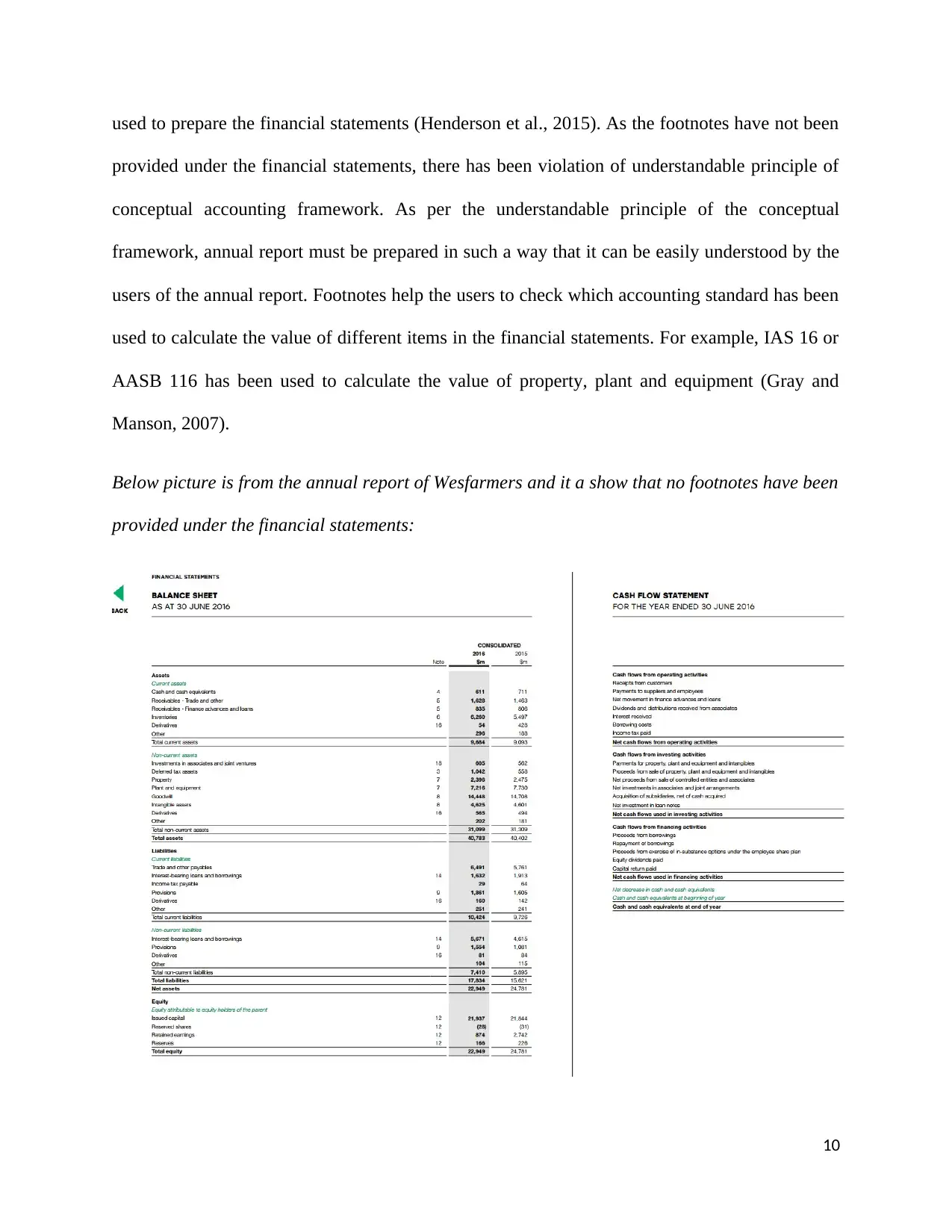
used to prepare the financial statements (Henderson et al., 2015). As the footnotes have not been
provided under the financial statements, there has been violation of understandable principle of
conceptual accounting framework. As per the understandable principle of the conceptual
framework, annual report must be prepared in such a way that it can be easily understood by the
users of the annual report. Footnotes help the users to check which accounting standard has been
used to calculate the value of different items in the financial statements. For example, IAS 16 or
AASB 116 has been used to calculate the value of property, plant and equipment (Gray and
Manson, 2007).
Below picture is from the annual report of Wesfarmers and it a show that no footnotes have been
provided under the financial statements:
10
provided under the financial statements, there has been violation of understandable principle of
conceptual accounting framework. As per the understandable principle of the conceptual
framework, annual report must be prepared in such a way that it can be easily understood by the
users of the annual report. Footnotes help the users to check which accounting standard has been
used to calculate the value of different items in the financial statements. For example, IAS 16 or
AASB 116 has been used to calculate the value of property, plant and equipment (Gray and
Manson, 2007).
Below picture is from the annual report of Wesfarmers and it a show that no footnotes have been
provided under the financial statements:
10
Paraphrase This Document
Need a fresh take? Get an instant paraphrase of this document with our AI Paraphraser
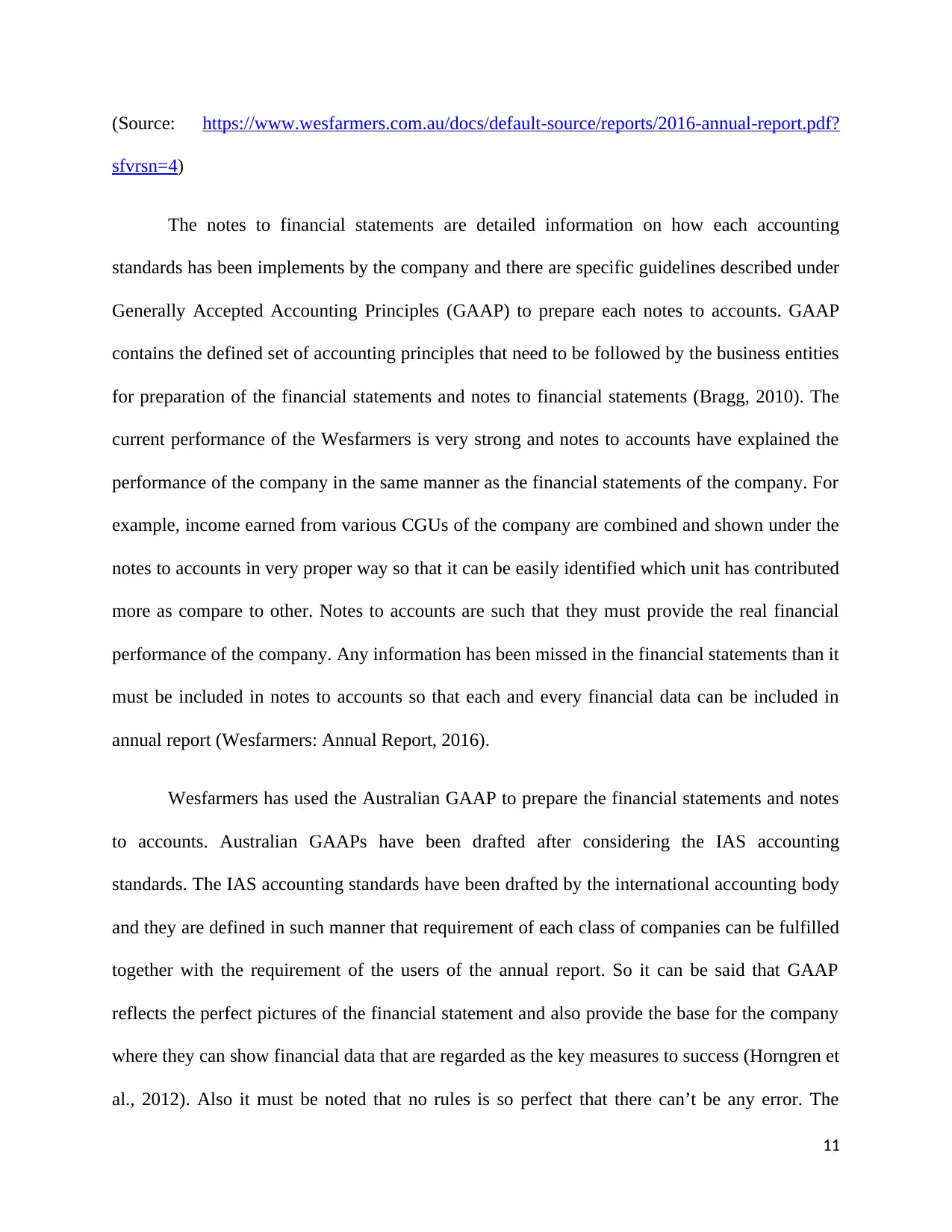
(Source: https://www.wesfarmers.com.au/docs/default-source/reports/2016-annual-report.pdf?
sfvrsn=4)
The notes to financial statements are detailed information on how each accounting
standards has been implements by the company and there are specific guidelines described under
Generally Accepted Accounting Principles (GAAP) to prepare each notes to accounts. GAAP
contains the defined set of accounting principles that need to be followed by the business entities
for preparation of the financial statements and notes to financial statements (Bragg, 2010). The
current performance of the Wesfarmers is very strong and notes to accounts have explained the
performance of the company in the same manner as the financial statements of the company. For
example, income earned from various CGUs of the company are combined and shown under the
notes to accounts in very proper way so that it can be easily identified which unit has contributed
more as compare to other. Notes to accounts are such that they must provide the real financial
performance of the company. Any information has been missed in the financial statements than it
must be included in notes to accounts so that each and every financial data can be included in
annual report (Wesfarmers: Annual Report, 2016).
Wesfarmers has used the Australian GAAP to prepare the financial statements and notes
to accounts. Australian GAAPs have been drafted after considering the IAS accounting
standards. The IAS accounting standards have been drafted by the international accounting body
and they are defined in such manner that requirement of each class of companies can be fulfilled
together with the requirement of the users of the annual report. So it can be said that GAAP
reflects the perfect pictures of the financial statement and also provide the base for the company
where they can show financial data that are regarded as the key measures to success (Horngren et
al., 2012). Also it must be noted that no rules is so perfect that there can’t be any error. The
11
sfvrsn=4)
The notes to financial statements are detailed information on how each accounting
standards has been implements by the company and there are specific guidelines described under
Generally Accepted Accounting Principles (GAAP) to prepare each notes to accounts. GAAP
contains the defined set of accounting principles that need to be followed by the business entities
for preparation of the financial statements and notes to financial statements (Bragg, 2010). The
current performance of the Wesfarmers is very strong and notes to accounts have explained the
performance of the company in the same manner as the financial statements of the company. For
example, income earned from various CGUs of the company are combined and shown under the
notes to accounts in very proper way so that it can be easily identified which unit has contributed
more as compare to other. Notes to accounts are such that they must provide the real financial
performance of the company. Any information has been missed in the financial statements than it
must be included in notes to accounts so that each and every financial data can be included in
annual report (Wesfarmers: Annual Report, 2016).
Wesfarmers has used the Australian GAAP to prepare the financial statements and notes
to accounts. Australian GAAPs have been drafted after considering the IAS accounting
standards. The IAS accounting standards have been drafted by the international accounting body
and they are defined in such manner that requirement of each class of companies can be fulfilled
together with the requirement of the users of the annual report. So it can be said that GAAP
reflects the perfect pictures of the financial statement and also provide the base for the company
where they can show financial data that are regarded as the key measures to success (Horngren et
al., 2012). Also it must be noted that no rules is so perfect that there can’t be any error. The
11
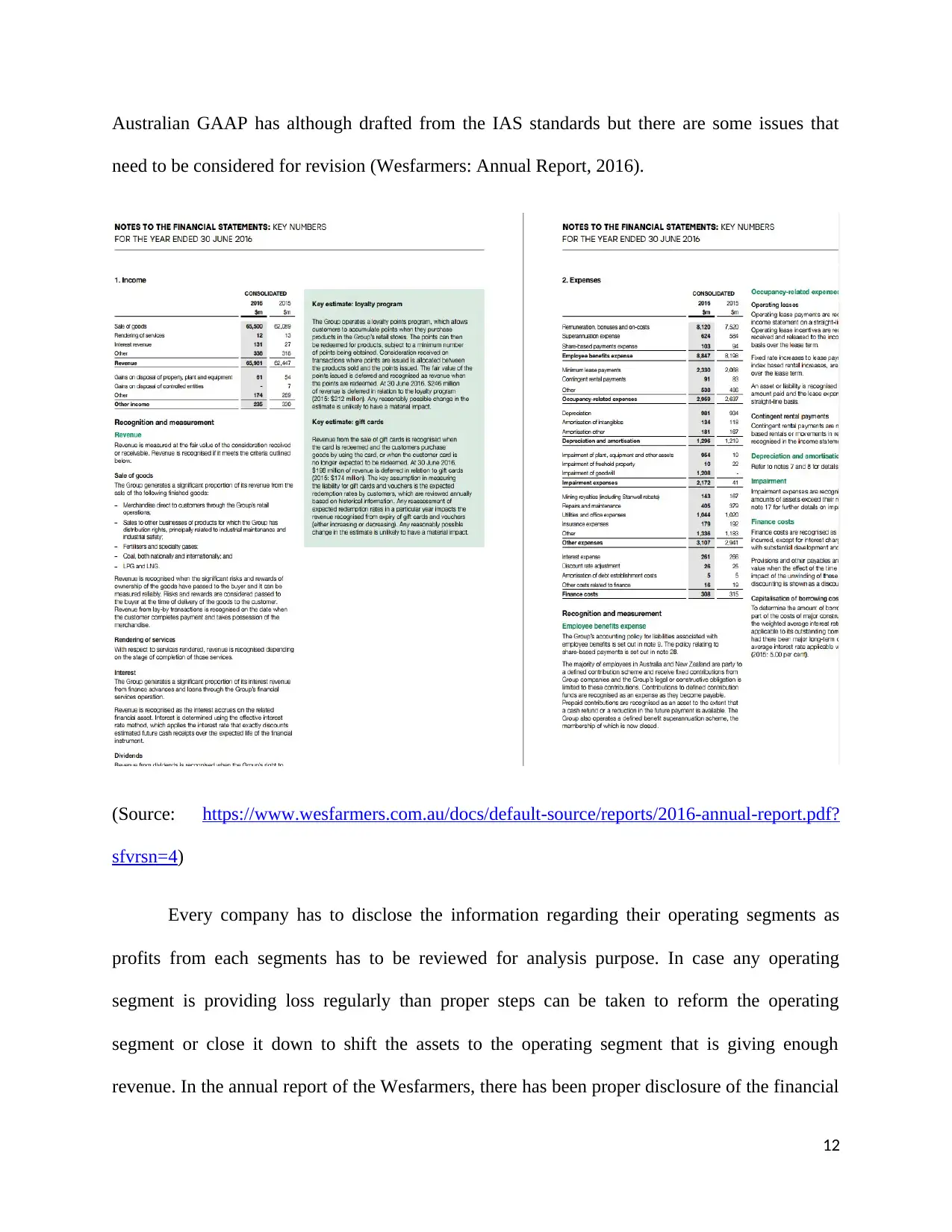
Australian GAAP has although drafted from the IAS standards but there are some issues that
need to be considered for revision (Wesfarmers: Annual Report, 2016).
(Source: https://www.wesfarmers.com.au/docs/default-source/reports/2016-annual-report.pdf?
sfvrsn=4)
Every company has to disclose the information regarding their operating segments as
profits from each segments has to be reviewed for analysis purpose. In case any operating
segment is providing loss regularly than proper steps can be taken to reform the operating
segment or close it down to shift the assets to the operating segment that is giving enough
revenue. In the annual report of the Wesfarmers, there has been proper disclosure of the financial
12
need to be considered for revision (Wesfarmers: Annual Report, 2016).
(Source: https://www.wesfarmers.com.au/docs/default-source/reports/2016-annual-report.pdf?
sfvrsn=4)
Every company has to disclose the information regarding their operating segments as
profits from each segments has to be reviewed for analysis purpose. In case any operating
segment is providing loss regularly than proper steps can be taken to reform the operating
segment or close it down to shift the assets to the operating segment that is giving enough
revenue. In the annual report of the Wesfarmers, there has been proper disclosure of the financial
12
⊘ This is a preview!⊘
Do you want full access?
Subscribe today to unlock all pages.

Trusted by 1+ million students worldwide
1 out of 21
Related Documents
Your All-in-One AI-Powered Toolkit for Academic Success.
+13062052269
info@desklib.com
Available 24*7 on WhatsApp / Email
![[object Object]](/_next/static/media/star-bottom.7253800d.svg)
Unlock your academic potential
Copyright © 2020–2025 A2Z Services. All Rights Reserved. Developed and managed by ZUCOL.





